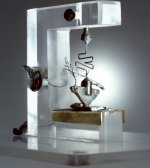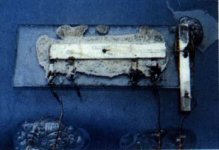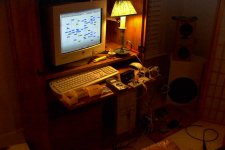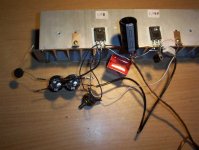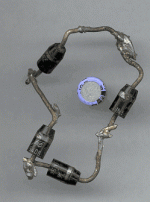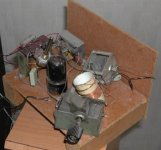Fred,
Is that the Bardeen/Brattley transistor that predated Schokleys
planar version? I have never seen pictures of it, just read about
it.
Maybe time for some semiconductor DIYing anybody? 🙂
BTW, maybe we should ask Upupa Epops to be the judge in this
contest. 🙂
Is that the Bardeen/Brattley transistor that predated Schokleys
planar version? I have never seen pictures of it, just read about
it.
Maybe time for some semiconductor DIYing anybody? 🙂
BTW, maybe we should ask Upupa Epops to be the judge in this
contest. 🙂
roddyama said:Tony,
I particularly like the soldering iron wounded wire.🙂
Yeah I'm not sure how that happened, could have been recycled wire 😉 definitely adds to the asthetics though
🙄
Tony.
Tim, I did not think that yours was spectacular, until I just noticed in the photo... the tube that is sticking straight up. Wow. All that and high voltage too!
What more can a guy ask for? It brings a tear to my eye.
Makes me feel like I am in first year digital/electronics class all over gain. breadboards... wires... rat's nests....
What more can a guy ask for? It brings a tear to my eye.
Makes me feel like I am in first year digital/electronics class all over gain. breadboards... wires... rat's nests....
Re: Not mine but........
Well I work at TI so I've been subjected to Kilby's prototype that came out some 10 years later....
1958 Integrated Circuit;
Fred Dieckmann said:The grandfather of ugly prototypes for all us Solid State nerds.
From Bell Labs in 1947
Well I work at TI so I've been subjected to Kilby's prototype that came out some 10 years later....
1958 Integrated Circuit;
Attachments
KBK said:Tim, I did not think that yours was spectacular, until I just noticed in the photo... the tube that is sticking straight up. Wow. All that and high voltage too!
Thankee! 😀 Indeed, that project had 400~450VDC on it.. nice that those breadboards can handle it 😉
It's cold in the basement so I've temporarily relocated... and this way I can plug around with stuff right when I get the urge, say after reading forums 🙂
Tim
Attachments
Oh, Tim does that bring a nostalgic tear to my eye! That's exactly what my living rooms looked like for years, until The Wild Child came along and I was banished to the garage.
I once soldered TDA2030 directly to speaker elements connectors just to test if element was working one, it was like gainclone, and it was ugly one 😀 Too bad i don't have pic of it 🙁
maybe this could be used to completely eliminate speaker cables, but then there would be lots of vibrations in amp...
maybe this could be used to completely eliminate speaker cables, but then there would be lots of vibrations in amp...
Well that made me feel a lot better! I've just returned from my semi-conductor lab... or as some people might see it, my computer desk.
I'm so annoyed! I have lost one soldering iron, I think I might have put it in the bin by accident, the station is in the post and I'm left with a 12 watt Weller iron, using a tip I made from a steel nail, with a heating element that gives a 240v sputtering sound when the lead isn't straight.
Have you ever tried to solder solid turrets with 1N5004 diodes and smothing capacitors on them using a 12 watt iron?
I love that point where the iron is just a fraction of a watt below the part's dissipation rating so you only melt the top 10th of a mm on a join.
I spent half an hour one day trying to solder a 1/4" jack with that iron. I ended up with burnt hands, melted plastic everywhere and a Bic lighter held under the tag trying to get it hot enough. I am serious. A new meaning to "forcing the heat in". It kept teasing me and sticking, then snapping back off. It never formed.
To keep up with this earthly approach, I recently made a few heater supplies using the E6 strings from my lead guitar for want of some copper wire.
I believe this is the only approach to wiring. At first the strings are new and electrically sterile sounding; cold. After many weeks of analog based musical energy being produced with them, the strings begin to take on a warm tone and are far more pleasing in audio systems than clean silver conductors. Due to some incredible convenience, which is proprietary information, I am able to get these strings... er... wires... on a regular basis. As such, I can offer you an amazing introductionary price of just $30,000 per metre*.
Please email if you're interested. Serious customers only!
*n.b. my version of a metre may not be the same as your version of a metre. strings may not actually improve audio performance of your system. strings may or may not be layered with cheap snack products.
Alternatively, I do have a poor ******* option available which is based around empty Kit Kat wrappers. These are kick *** conductors but you may need to increase your voltages to somewhere closer to a few kV to achieve a conductive thru the chocolate smudges.
John
I'm so annoyed! I have lost one soldering iron, I think I might have put it in the bin by accident, the station is in the post and I'm left with a 12 watt Weller iron, using a tip I made from a steel nail, with a heating element that gives a 240v sputtering sound when the lead isn't straight.
Have you ever tried to solder solid turrets with 1N5004 diodes and smothing capacitors on them using a 12 watt iron?
I love that point where the iron is just a fraction of a watt below the part's dissipation rating so you only melt the top 10th of a mm on a join.
I spent half an hour one day trying to solder a 1/4" jack with that iron. I ended up with burnt hands, melted plastic everywhere and a Bic lighter held under the tag trying to get it hot enough. I am serious. A new meaning to "forcing the heat in". It kept teasing me and sticking, then snapping back off. It never formed.
To keep up with this earthly approach, I recently made a few heater supplies using the E6 strings from my lead guitar for want of some copper wire.
I believe this is the only approach to wiring. At first the strings are new and electrically sterile sounding; cold. After many weeks of analog based musical energy being produced with them, the strings begin to take on a warm tone and are far more pleasing in audio systems than clean silver conductors. Due to some incredible convenience, which is proprietary information, I am able to get these strings... er... wires... on a regular basis. As such, I can offer you an amazing introductionary price of just $30,000 per metre*.
Please email if you're interested. Serious customers only!
*n.b. my version of a metre may not be the same as your version of a metre. strings may not actually improve audio performance of your system. strings may or may not be layered with cheap snack products.
Alternatively, I do have a poor ******* option available which is based around empty Kit Kat wrappers. These are kick *** conductors but you may need to increase your voltages to somewhere closer to a few kV to achieve a conductive thru the chocolate smudges.

John
hmmmmm...... first ever bridge rectifier
Was going through the parts box last night looking for some resistors (drawback of being colour blind, can't be sure at the shop that what the parts bins are labeled as are actually correct), and found the first bridge rectifier I ever made (was probably one of the first things I ever soldered which shows!!!!!)
I included an 8mm dia cap for scale. I'm not sure what I made it for but I suspect it was for my first amp (10W/channel) and the diodes were way bigger than necessary, would have found them in an old TV or something.
Tony.
Was going through the parts box last night looking for some resistors (drawback of being colour blind, can't be sure at the shop that what the parts bins are labeled as are actually correct), and found the first bridge rectifier I ever made (was probably one of the first things I ever soldered which shows!!!!!)
I included an 8mm dia cap for scale. I'm not sure what I made it for but I suspect it was for my first amp (10W/channel) and the diodes were way bigger than necessary, would have found them in an old TV or something.
Tony.
Attachments
Re: hmmmmm...... first ever bridge rectifier
we got a winner 😀
wintermute said:Was going through the parts box last night looking for some resistors (drawback of being colour blind, can't be sure at the shop that what the parts bins are labeled as are actually correct), and found the first bridge rectifier I ever made (was probably one of the first things I ever soldered which shows!!!!!)
I included an 8mm dia cap for scale. I'm not sure what I made it for but I suspect it was for my first amp (10W/channel) and the diodes were way bigger than necessary, would have found them in an old TV or something.
Tony.
we got a winner 😀
[OT] color blind
Do you know of WhatColor (http://www.hikarun.com/e/)?
Does help me a lot to decipher color-coded graphs etc. on the WWW.
Now, if I only had a version of this for real life...
Regards,
Peter Jacobi
wintermute said:[...] (drawback of being colour blind, can't be sure at the shop that what the parts bins are labeled as are actually correct)[...]
Do you know of WhatColor (http://www.hikarun.com/e/)?
Does help me a lot to decipher color-coded graphs etc. on the WWW.
Now, if I only had a version of this for real life...
Regards,
Peter Jacobi
Re: [OT] color blind
Thanks Peter,
Just downloaded it, I think it will come in very handy.
edit: need a handheld computer with a built in camera, then you would have a version for real life 🙂
Tony.
pjacobi said:
Do you know of WhatColor (http://www.hikarun.com/e/)?
Does help me a lot to decipher color-coded graphs etc. on the WWW.
Now, if I only had a version of this for real life...
Regards,
Peter Jacobi
Thanks Peter,
Just downloaded it, I think it will come in very handy.
edit: need a handheld computer with a built in camera, then you would have a version for real life 🙂
Tony.
Almost audio
I dug into my boxes of stored junk from history...
I found my old regenerative receiver prototype.
It works. Tube is a 6SN7 with one half being the detector and the other an audio amplifier. Plate supply 12V. It tunes the lower part of the shortwave band with the larger variable cap and the regeneration is controlled by the smaller, the "throttle".
😉
I dug into my boxes of stored junk from history...
I found my old regenerative receiver prototype.
It works. Tube is a 6SN7 with one half being the detector and the other an audio amplifier. Plate supply 12V. It tunes the lower part of the shortwave band with the larger variable cap and the regeneration is controlled by the smaller, the "throttle".
😉
Attachments
Ulgyness - 75 / 100
Seemingly directionless wiring earns it a great
number of ugly points. However, I felt injust in
awarding a higher score due to the kind of cute
looking wooden stand, that looks like it might have
taken at least four minutes to fabricate. I am
particularly impressed by the use of quite straight
edges, but this does not help the score. Had there
been any markings on the stand, this could have
taken ten or twenty points away. The the use of fibre
board and uncovered, chassis / frame mount
component's is a definite addition. An excellent
uglyness score!
Lethality - 40 / 100
Again, the wiring alone could earn it a first
class lethality rating, but you mentioned
12V, which is far too safe. There is also too much
insulated wire here. I am hoping that there is
at least a mains transformer involved somewhere.
Had this been a 400v circuit, with an electrolytic can
within it, this could have easily made 90 points or
more.
Function - 100 / 100
I decided to add a functionality extra. I
have awarded the 100 points as an ugly
prototype that works still beats one that
doesn't. If it doesn't work, it's not a
prototype. Intermittent operation would
score +50 only, for instance, if you require
help from someone else while testing the
circuit, since eight seperate wires need
holding 'the right way' for it to work.
Overall - 215 / 300
33 - C minus
66 - C
99 - C plus
132 - B minus
164 - B
196 - B plus
228 - A minus <-- Jax's Regenerative Receiver
260 - A
292 - A plus
300 - First class prototype, with merit
- Status
- Not open for further replies.
- Home
- General Interest
- Everything Else
- Ugly prototype contest
